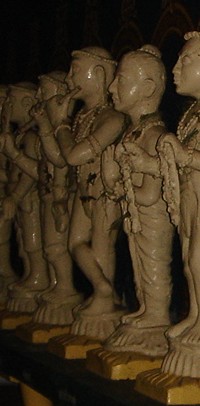
Manakanchara Nayanar, also known as Manakkanychaara Nayanar, Manakkancharar, Manakanjara Nayanar, Mankkanjara Nayanar and Manakkanjarar, was a Nayanar saint, venerated in the Hindu sect of Shaivism. He is generally counted as the twelfth in the list of 63 Nayanars. Like other Nayanars, he was a fervent devotee of the god Shiva. Manakanchara Nayanar is dated to the 8th century and was a contemporary of Eyarkon Kalikkama Nayanar, a Nayanar saint and his son-in-law as well as Sundarar. He is described to have cut his daughter's hair and given it to Shiva disguised as a Shaiva ascetic, on her wedding day.

Kotpuli, also known as Kotpuliyar and Kotpuli Nayanar, was a Nayanar saint, venerated in the Hindu sect of Shaivism. He is generally counted as the fifty-seventh in the list of 63 Nayanars.
Dandi Adigal Nayanar or Dandiyadigal Nayanar is the 31st Nayanar saint. Traditional hagiographies like Periya Puranam and Thiruthondar Thogai describe him as a great devotee of the Hindu god Shiva.
Muruga Nayanar or Muruka Nayanar is the 15th Nayanar saint. Traditional hagiographies like Periya Puranam and Thiruthondar Thogai describe him as a great devotee of the Hindu god Shiva. He is described to have lived an ascetic life, filled with austerity and selfless devotion to Shiva, spending his time in collecting flowers from woodlands and decorating the Shiva Lingam with garlands and coronets.
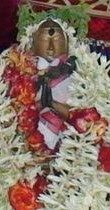
Apputhi Adigal, also spelt as Apputhi Adikal, Atputhi Adigal, Apputi Adigal, Appoodi Adikal, Appoothi Adikal and Appudhi Adigal and known as Appuddi Nayanar, was a Nayanar saint, venerated in the Hindu sect of Shaivism. He is generally counted as the twenty-fifth in the list of 63 Nayanars. He is described as a contemporary of Appar or Thirunavukkarasar, one of the most prominent Nayanars.
Yenathinathar, also known as Yenatinata, Yenathi Nayanar, Yenadhinatha, Yenadinath, Yenadinatha Nayanar and Yenadhinatha Nayanar, was a Nayanar saint hailing from ezhakula Channar clan, venerated in the Hindu sect of Shaivism. He is generally counted as the ninth in the list of 63 Nayanars. In 1901, P.Sv. Perumal Nadar formed Srimath Yenathinadha Nayanar Thirumadalayam at Aruppukottai

Sakkiya Nayanar was a Nayanar saint, venerated in the Shaiva sect of Hinduism. He is generally counted as the thirty-fourth in the list of 63 Nayanars. He was a Buddhist, who converted to Shaivism.
Satti Nayanar, also known as Satti (Sathi), Sathiyar, Shakti Nayanar, Shakti, Shaktiyar (Saktiyar), Sattiyandar and Thiru-Saththi Nayanar, is a Nayanar saint, venerated in the Hindu sect of Shaivism. He is generally counted as the 45th in the list of 63 Nayanars. Satti Nayanar is described to cut off the tongue of whoever talked ill of his patron god Shiva or Shiva's devotees.
Kungiliya Kalaya Nayanar, also known as Kungiliya Kalaya, Kalayar, Kunguliya and Kalaya Nayanar, is a Nayanar saint, venerated in the Hindu sect of Shaivism. He is generally counted as the eleventh in the list of 63 Nayanars.
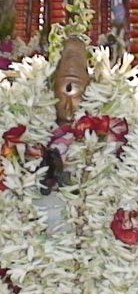
Murthi Nayanar, also spelt as Murthy Nayanar, Moorthy Nayanar and Murti Nayanar and also known as Murtti, is a Nayanar saint, venerated in the Hindu sect of Shaivism. He is generally counted as the fifteenth in the list of 63 Nayanars.
Somasi Mara Nayanar, also known as Somasi Maranar, Somasi Marar, Somasimarar and Somasira Nayanar, is a Nayanar saint, venerated in the Hindu sect of Shaivism. He is generally counted as the thirty-third in the list of 63 Nayanars. He is also called Marar, Maran and Mara Nayanar, names he shares with Ilayankudi Mara Nayanar. The two Nayanars are generally differentiated by the prefixes "Somasi" and "Ilayankudi". He was a contemporary and devotee of Sundarar.
Eyarkon Kalikkama Nayanar, also known as Kalikkamanar, Kalikamba Nayanar, was a King of Haihaya (Eyar), Commander-in-chief of the Chola army, a Nayanar saint, venerated in the Hindu sect of Shaivism. He is generally counted as the 29th in the list of 63 Nayanars.
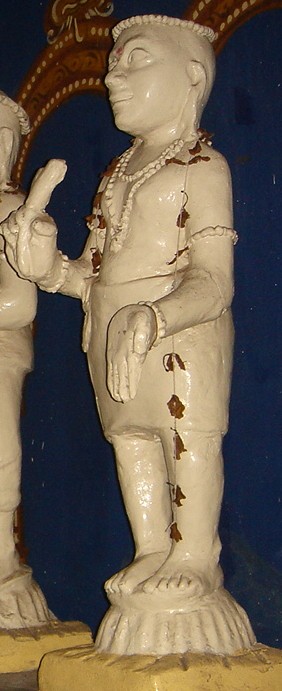
Eripatha Nayanar, also known as Eripathar, Eripatar, Eribattar, Eripattan', Eripaththa Nayanar and Eripattha Nayanar, is Nayanar saint, venerated in the Hindu sect of Shaivism. He is generally counted as the eighth in the list of 63 Nayanars.
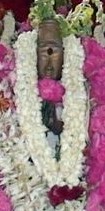
Pugal Chola, also known as Pukal Chola, Pukazhchozha Nayanar, Pugazh, Pukazhcchozhar, Pukal Cholan and Pugal Chola Nayanar, is described as a Chola ruler and was a Nayanar saint, venerated in Shaivism, one of the main sects of Hindu. He is generally counted as the eighth in the list of 63 Nayanars.

Sirappuli Nayanar, also known as Sirappuli, Sirapuli Nayanar, Sirappuliyar (Chirappuliyar), was a Nayanar saint, venerated in the Hindu sect of Shaivism. He is generally counted as the thirty-fifth in the list of 63 Nayanars. Sirappuli Nayanar is described to have served the devotees of the god Shiva and worshipped the god with various ritual practices.

Seruthunai Nayanar, also known as Seruthunai, Seruthunaiyar and Seruttunai Nayanar, was a Nayanar saint, venerated in the Hindu sect of Shaivism. He is generally counted as the 55th in the list of 63 Nayanars.
Amaraneedi Nayanar, also known as Amarneethi (Nayanar), Amarneeti (Nayanar), Amarniti (Nayanar), Amar-Nidhi (Nayanar) and Amarneethiyar, was a Nayanar saint, venerated in the Hindu sect of Shaivism. He is generally counted as the seventh in the list of 63 Nayanars.
Nesa Nayanar, also known as Sivanesa Nayanar, Neca Nayanar, Nesanar, Nesar and Nesan (Necan), was a Nayanar saint, venerated in the Hindu sect of Shaivism. He is generally counted as the fifty-ninth in the list of 63 Nayanars. Nesa Nayanar is described to be a weaver, who was always engrossed in remembering his patron god Shiva and gifting clothes he knit to devotees of the deity.

Kutruva Nayanar, also known as Kootruva , Kutruva, Kutruvar, Kootruvar, Kurruva Nayanar, Kurruvar, Kurruvan, Kutruvanar, Kurrrruvar, Kalappallan and Kalappalar, was a chieftain of Kalandai and a Nayanar saint, venerated in the Hindu sect of Shaivism. He is generally counted as the 39th in the list of 63 Nayanars. Kutruva is often described as a Jain, who became a devotee of Shiva, the patron god of Shaivism.

Iyarpagai Nayanar, also known as Iyarpagaiar, Iyarpahai Nayanar, Iyarpagaiya Nayanar and Iyarppakai Nayanar is a Nayanar saint, venerated in the Hindu sect of Shaivism. He is generally counted as the third in the list of 63 Nayanars.
